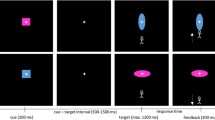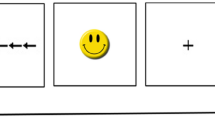Abstract
Research has shown that affective stimuli automatically trigger responses that ultimately cause a compatible distance change (positive-approach, negative-avoidance), even when this requires an initial movement in the opposite and thus incompatible direction (detour). It is unclear, however, which features of automaticity apply to this effect. The present study investigated whether this effect depends on the goal to evaluate stimulus valence. Participants responded with approach and avoidance movements to affective stimuli. Half of the trials required a detour, i.e., participants initially moved in the direction opposite to the position ultimately intended. The goal of stimulus evaluation was manipulated between participants (present vs. absent). Affective stimuli facilitated ultimately compatible approach–avoidance responses even in the absence of evaluation goals, albeit the effect was larger when evaluation goals were present. The present findings suggest that distance regulation towards and away from affective stimuli is farsighted and automatic at the same time .


Similar content being viewed by others
Notes
Analyses including these participants revealed corresponding results.
To validate the results, we conducted additional analyses, where we discarded responses with latencies below 150 ms and above 2500 ms. These analyses revealed corresponding results.
For the sake of completeness, we also analyzed error rates. Note however, that response latencies are regarded as the primary dependent variable in approach–avoidance tasks (Laham et al. 2015; Phaf et al. 2014), because without response deadlines meaningful variations reliably occur in response latencies, but not in error rates. A 2 (evaluation goal: present vs. absent) × 2 (ultimate compatibility: compatible vs. incompatible) × 2 (pathway: straight vs. winding) mixed ANOVA for repeated measures yielded a significant main effect of pathway, F(1, 160) = 47.32, p < .001, ηp2 = 0.23, a significant main effect of ultimate compatibility, F(1, 160) = 15.62, p < .001, ηp2 = 0.09, and a significant interaction between ultimate compatibility and evaluation goal, F(1, 160) = 6.23, p = .014, ηp2 = 0.04. No other effects were significant, all Fs < 2.2, ps > .14. Separate t-tests revealed significant VAAC-effects on straight pathways with evaluation goals, t(83) = 3.86, p < .001, dz = 0.42, 95% CI [0.01, 0.02], on winding pathways with evaluation goals, t(83) = 2.81, p = .006, dz = 0.31, 95% CI [0.005, 0.03], on straight pathways without evaluation goals, t(77) = 2.43, p = .018, dz = 0.28, 95% CI [0.002, 0.02], but not on winding pathways without evaluation goals, t(77) = 0.43, p = .67, dz = 0.05, 95% CI [− 0.01, 0.02].
References
Bamford, S., & Ward, R. (2008). Predispositions to approach and avoid are contextually sensitive and goal dependent. Emotion, 8, 174–183. https://doi.org/10.1037/1528-3542.8.2.174.
Bargh, J. A. (1992). The ecology of automaticity: Toward establishing the conditions needed to produce automatic processing effects. The American Journal of Psychology, 105, 181–199. https://doi.org/10.2307/1423027.
Beatty, G. F., Cranley, N. M., Carnaby, G., & Janelle, C. M. (2016). Emotions predictably modify response times in the initiation of human motor actions: A meta-analytic review. Emotion, 16, 237–251. https://doi.org/10.1037/emo0000115.
Cacioppo, J. T., Priester, J. R., & Berntson, G. G. (1993). Rudimentary determinants of attitudes II: Arm flexion and extension have differential effects on attitudes. Journal of Personality and Social Psychology, 65, 5–17. https://doi.org/10.1037/0022-3514.65.1.5.
Chen, M., & Bargh, J. A. (1999). Consequences of automatic evaluation: Immediate behavioral predispositions to approach or avoid the stimulus. Personality and Social Psychology Bulletin, 25, 215–224. https://doi.org/10.1177/0146167299025002007.
De Houwer, J., Crombez, G., Baeyens, F., & Hermans, D. (2001). On the generality of the affective Simon effect. Cognition & Emotion, 15, 189–206. https://doi.org/10.1080/0269993004200051.
Eder, A. B., & Rothermund, K. (2008). When do motor behaviors (mis)match affective stimuli? An evaluative coding view of approach and avoidance reactions. Journal of Experimental Psychology: General, 137, 262–281. https://doi.org/10.1037/0096-3445.137.2.262.
Faul, F., Erdfelder, E., Lang, A. G., & Buchner, A. (2007). G*Power 3: A flexible statistical power analysis program for the social, behavioral, and biomedical sciences. Behavior Research Methods, 39, 175–191. https://doi.org/10.3758/BF03193146.
Gray, J. A. (1987). The psychology of fear and stress. Cambridge: Cambridge University Press.
Hager, W., & Hasselhorn, M. (Eds.). (1994). Handbuch deutschsprachiger Wortnormen [Handbook of german word norms]. Göttingen: Hogrefe.
James, W. (1890). The principles of psychology (Vol. 2). Cambridge, MA: Havard University Press.
Janczyk, M., Durst, M., & Ulrich, R. (2017). Action selection by temporally distal goal states. Psychonomic Bulletin & Review, 24, 467–473. https://doi.org/10.3758/s13423-016-1096-4.
Kiesel, A., & Hoffmann, J. (2004). Variable action effects: Response control by context-specific effect anticipations. Psychological Research Psychologische Forschung, 68, 155–162. https://doi.org/10.1007/s00426-003-0152-7.
Klauer, K. C., & Musch, J. (1999). Eine Normierung unterschiedlicher Aspekte der evaluativen Berwertung von 92 Substantiven [A standardization of various aspects of the evaluation of 92 nouns]. Zeitschrift für Sozialpsychologie, 30, 1–11. https://doi.org/10.1024//0044-3514.30.1.1.
Kozlik, J., Neumann, R., & Lozo, L. (2015). Contrasting motivational orientation and evaluative coding accounts: On the need to differentiate the effectors of approach/avoidance responses. Frontiers in Psychology, 6, 563. https://doi.org/10.3389/fpsyg.2015.00563.
Krieglmeyer, R., De Houwer, J., & Deutsch, R. (2011). How farsighted are behavioral tendencies of approach and avoidance? The effect of stimulus valence on immediate vs. ultimate distance change. Journal of Experimental Social Psychology, 47, 622–627. https://doi.org/10.1016/j.jesp.2010.12.021.
Krieglmeyer, R., De Houwer, J., & Deutsch, R. (2013). On the nature of automatically triggered approach-avoidance behavior. Emotion Review, 5, 280–284. https://doi.org/10.1177/1754073913477501.
Krieglmeyer, R., & Deutsch, R. (2010). Comparing measures of approach-avoidance behaviour: The manikin task vs. two versions of the joystick task. Cognition & Emotion, 24, 810–828. https://doi.org/10.1080/02699930903047298.
Krieglmeyer, R., Deutsch, R., De Houwer, J., & De Raedt, R. (2010). Being moved: Valence activates approach-avoidance behavior independently of evaluation and approach-avoidance intentions. Psychological Science, 21, 607–613. https://doi.org/10.1177/0956797610365131.
Kunde, W. (2001). Response-effect compatibility in manual choice reaction tasks. Journal of Experimental Psychology: Human Perception and Performance, 27, 387. https://doi.org/10.1037//0096-1523.27.2.387.
Kunde, W., Elsner, K., & Kiesel, A. (2007). No anticipation-no action: The role of anticipation in action and perception. Cognitive Processing, 8, 71–78. https://doi.org/10.1007/s10339-007-0162-2.
Laham, S. M., Kashima, Y., Dix, J., & Wheeler, M. (2015). A meta-analysis of the facilitation of arm flexion and extension movements as a function of stimulus valence. Cognition and Emotion, 29, 1069–1090. https://doi.org/10.1080/02699931.2014.968096.
Lang, P. J., Bradley, M. M., & Cuthbert, B. N. (1990). Emotion, attention, and the startle reflex. Psychological Review, 97, 377–395. https://doi.org/10.1037/0033-295X.97.3.377.
Lavender, T., & Hommel, B. (2007). Affect and action: Towards an event-coding account. Cognition & Emotion, 21, 1270–1296. https://doi.org/10.1080/02699930701438152.
Markman, A. B., & Brendl, C. M. (2005). Constraining theories of embodied cognition. Psychological Science, 16, 6–10. https://doi.org/10.1111/j.0956-7976.2005.00772.x.
Moors, A., & De Houwer, J. (2006). Automaticity: A theoretical and conceptual analysis. Psychological Bulletin, 132, 297–326. https://doi.org/10.1037/0033-2909.132.2.297.
Neumann, R., Förster, J., & Strack, F. (2003). Motor compatibility: The bidirectional link between behavior and evaluation. In J. Musch & K. C. Klauer (Eds.), The psychology of evaluation (pp. 371–391). London: Lawrence Erlbaum Associates.
Phaf, R. H., Mohr, S. E., Rotteveel, M., & Wicherts, J. M. (2014). Approach, avoidance, and affect: A meta-analysis of approach-avoidance tendencies in manual reaction time tasks. Frontiers in Psychology, 5, 378. https://doi.org/10.3389/fpsyg.2014.00378.
Rinck, M., & Becker, E. S. (2007). Approach and avoidance in fear of spiders. Journal of Behavior Therapy and Experimental Psychiatry, 38, 105–120. https://doi.org/10.1016/j.jbtep.2006.10.001.
Rotteveel, M., & Phaf, R. H. (2004). Automatic affective evaluation does not automatically predispose for arm flexion and extension. Emotion, 4, 156–172. https://doi.org/10.1037/1528-3542.4.2.156.
Seibt, B., Neumann, R., Nussinson, R., & Strack, F. (2008). Movement direction or change in distance? Self and object related approach-avoidance movements. Journal of Experimental Social Psychology, 44, 713–720. https://doi.org/10.1016/j.jesp.2007.04.013.
van Dantzig, S., Pecher, D., & Zwaan, R. A. (2008). Approach and avoidance as action effects. Quarterly Journal of Experimental Psychology, 61, 1298–1306. https://doi.org/10.1080/17470210802027987.
Author information
Authors and Affiliations
Corresponding author
Ethics declarations
Conflict of interest
The author declares that she has no conflict of interest.
Ethical approval
All procedures performed in studies involving human participants were in accordance with the ethical standards of the institutional and/or national research committee and with the 1964 Helsinki declaration and its later amendments or comparable ethical standards.
Informed consent
Informed consent was obtained from all individual participants included in the study.
Rights and permissions
About this article
Cite this article
Reichardt, R. Farsighted and automatic: Affective stimuli facilitate ultimately compatible approach–avoidance tendencies even in the absence of evaluation goals. Motiv Emot 42, 738–747 (2018). https://doi.org/10.1007/s11031-018-9680-8
Published:
Issue Date:
DOI: https://doi.org/10.1007/s11031-018-9680-8




